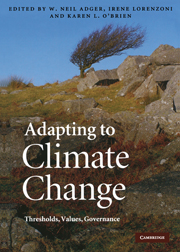Book contents
- Frontmatter
- Contents
- List of contributors
- Preface
- 1 Adaptation now
- Part I Adapting to thresholds in physical and ecological systems
- 2 Ecological limits of adaptation to climate change
- 3 Adapting to the effects of climate change on water supply reliability
- 4 Protecting London from tidal flooding: limits to engineering adaptation
- 5 Climate prediction: a limit to adaptation?
- 6 Learning to crawl: how to use seasonal climate forecasts to build adaptive capacity
- 7 Norse Greenland settlement and limits to adaptation
- 8 Sea ice change in Arctic Canada: are there limits to Inuit adaptation?
- Part II The role of values and culture in adaptation
- Part III Governance, knowledge and technologies for adaptation
- 31 Conclusions: Transforming the world
- Index
- References
6 - Learning to crawl: how to use seasonal climate forecasts to build adaptive capacity
Published online by Cambridge University Press: 31 August 2009
- Frontmatter
- Contents
- List of contributors
- Preface
- 1 Adaptation now
- Part I Adapting to thresholds in physical and ecological systems
- 2 Ecological limits of adaptation to climate change
- 3 Adapting to the effects of climate change on water supply reliability
- 4 Protecting London from tidal flooding: limits to engineering adaptation
- 5 Climate prediction: a limit to adaptation?
- 6 Learning to crawl: how to use seasonal climate forecasts to build adaptive capacity
- 7 Norse Greenland settlement and limits to adaptation
- 8 Sea ice change in Arctic Canada: are there limits to Inuit adaptation?
- Part II The role of values and culture in adaptation
- Part III Governance, knowledge and technologies for adaptation
- 31 Conclusions: Transforming the world
- Index
- References
Summary
Introduction: climate variability and climate change
The Pacific Ocean covers almost half the Earth. Its east–west axis is longest near the Equator, and it is here that the related processes of El Niño and the Southern Oscillation, together known as ENSO, take place. El Niño refers to the periodic warming of the surface waters in the eastern tropical Pacific, while the Southern Oscillation refers to the fluctuation in air pressure differential between Darwin, Australia and Tahiti. What determines the periodicity of ENSO is the time it takes for pressure waves to cross from Indonesia to South America, and then bounce back again. Because the ocean is so wide, that process takes several years. Because there is so much water there, and water holds a lot of energy, ENSO phases can alter weather patterns around the world.
Inter-annual climate variability of this sort has always existed. In terms of human experience, it is likely that people have and will continue to experience climate change not as a gradual rise in temperature, but rather as a shift in the frequency and intensity of particular weather events. Climatic risks and climate variability are a substantial drain on the economies of least developed countries, and indeed the effects of climate variability on society are significantly greater than the effects of climate change probably will be, at least for the next 30 years (Hulme et al., 1999).
- Type
- Chapter
- Information
- Adapting to Climate ChangeThresholds, Values, Governance, pp. 79 - 95Publisher: Cambridge University PressPrint publication year: 2009



